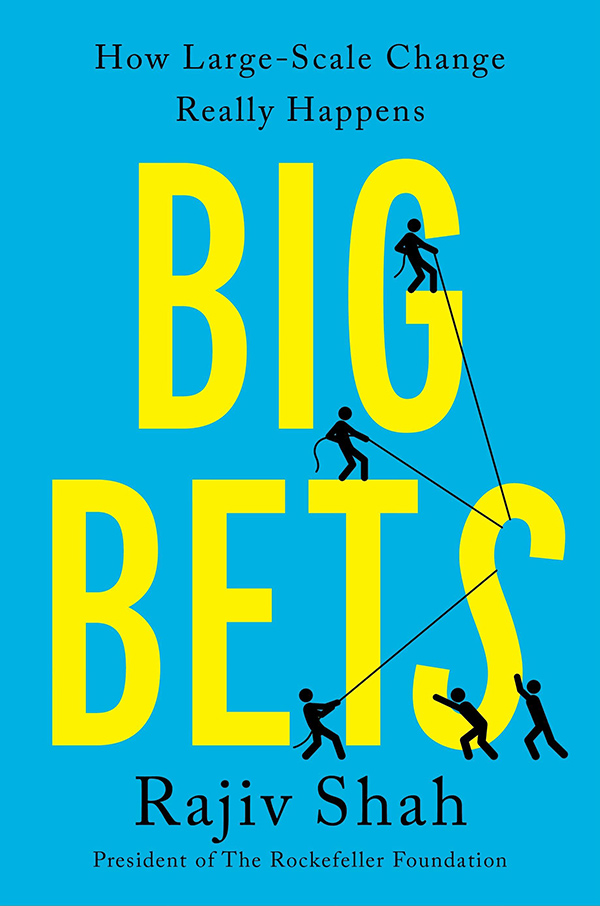Leaders who limit solutions to those that are provable are unlikely to come up with great answers, says Roger Martin. To encourage the “vital elusive spark of creativity,” leaders need to support design thinking, going beyond the limits of inductive and deductive logic to access the blended wisdom of abductive logic, where knowledge is derived from mystery.
 Martin has served as dean of the Rotman School of Management at the University of Toronto since 1998. Before that he was a director of Monitor Company, a global-strategy consulting firm in Cambridge, Mass. In 2010, Business Week named Martin one of the 27 most influential designers in the world, and in 2009, The (London) Times and Forbes.com named him one of the 50 top management thinkers in the world. His books include “The Design of Business,” “The Opposable Mind” and “The Responsibility Virus.”
Martin has served as dean of the Rotman School of Management at the University of Toronto since 1998. Before that he was a director of Monitor Company, a global-strategy consulting firm in Cambridge, Mass. In 2010, Business Week named Martin one of the 27 most influential designers in the world, and in 2009, The (London) Times and Forbes.com named him one of the 50 top management thinkers in the world. His books include “The Design of Business,” “The Opposable Mind” and “The Responsibility Virus.”
Recently Martin spoke with Faith & Leadership about leadership strategies of opposable thinking and abductive logic. The following is an edited transcript.
Q: What is opposable thinking, and how do you teach it?
Lots of people do it reflectively. Right? I might say, “Gee, you’ve got to do either A or B, and you can’t do both.” So you analyze A and analyze B and figure out what seems to be the better between the two and then do it. One thing we have to do is say, “No, you always have a different choice than is presented to you.”
There are a few pieces to it. One is an awareness that you don’t have to choose between opposing options. There is another choice. Every choice you have is based on a model. In order to access the underlying structures of those models to do the construction of a new model, you need to be able to say, “Well, why is that the case?”
If you say, “You can be a low-cost retailer like a Wal-Mart or a high-cost retailer like Nordstrom,” well, what’s the Wal-Mart model? What are the building blocks that get you to the Wal-Mart model? What are the building blocks that get you to the Nordstrom model? It’s in those pieces of the structure that you find the clues to building a new model. We teach how to rebuild with pieces of those models, and then we teach a technique for searching for new models.
If you’re a retailer choosing between being a Wal-Mart and being a Nordstrom, and you don’t like either of them, you can come up with the insight that Target came up with: As long as you view the store as one store, you’ve either got to be like Wal-Mart or Nordstrom -- or you can say, “Actually, there are two stores-within-a-store.”
There is one store-within-a-store that is selling products that are comparison-shopped. So if you buy Tide in Target or Tide in Wal-Mart, it doesn’t matter. It’s the same Tide. That’s one part of the store, but there’s another part of the store that has non-comparable products. If you can go to designers and create private-label versions of sweaters and shirts and the like, you can get customers to buy something without comparison. They don’t have any comparison reference, but it’s a great design and is much lower priced than a similar thing at Nordstrom. That’s the Target model: pay less, expect more. They disaggregated the models and said, “You can actually have two stores-within-a-store -- a comparison store and a unique store -- and, in combination, that will allow you to build a great retail chain.”
We teach these handfuls of integration to look for once you’ve got opposing models. There are various ways to get around Model A versus Model B, and that’s what we teach.
Q: In your newest book, “The Design of Business,” you talk about blending approaches using abductive reasoning. What does that mean, and why is it important?
Abductive reasoning comes from a philosopher named Charles Sanders Peirce. If you look at all the new ideas in the world, you cannot demonstrate how any one of them came about via deductive or inductive logic. Therefore, there must be a third kind of logic: abductive logic is an inference, or a logical leap of the mind.
If you see something that’s anomalous and you don’t understand it, you are left with the task of making an inference as to what’s the best explanation for that thing. If you see something about customers that you don’t understand, by figuring out the best explanation, you can come up with a new model, but that takes a logical leap. It’s not a linear process, where you can analyze your way to it. You’ve got to make some form of a logical leap.
Q: Does some kind of intuition come into play?
Absolutely, although that’s kind of a loaded word. It depends what you mean by “intuition.” I think intuition is a product of all your previous experiences that you can bring to bear on that anomalous point of view and see, “Well, what useful thing can I draw from that?”
Q: What’s the connection between abductive reasoning and thinking like a designer?
A design thinker can draw on both the traditional forms of analytical thinking -- inductive and deductive logic -- and abductive logic. So a crazy, creative person who every once in a while comes up with a one-off solution is an abductive reasoner only. But that often doesn’t get you very far in organizations, because organizations have to sustain themselves and do things repeatedly, and so a design thinker is somebody who feels comfortable and is capable of using both their analytical and intuitive sides, both their inductive and deductive logic and their abductive logic.
Most people in business suppress their abductive logic. I used to. I used to think that my job was to be an analyst, and now I don’t. And I’m a much better and a more useful businessperson now. I became much more useful when I allowed myself to use abductive logic.
Q: You’ve pointed out that organizational leaders tend to extinguish the “vital elusive spark of creativity” when it flares up. How do you change that?
It’s not easy. It takes real leadership, but one thing I’d say is ban the words “Prove it.” If you allow the use of those two words, you will extinguish or defeat all new ideas, because you cannot prove any new idea in advance.
Q: By requiring success in advance, you’re killing off new ideas.
Yup. If you limit your insights to provable ones, it is unlikely that you’ll come up with great answers. You’ll come up with marginal refinements of where you are not, and not something transformational. Again, it’s a blend. All of my work can be a work of blending things. It’s not as though you can ignore data analysis facts, but you cannot be controlled by them.
Q: Do you think that everyone in an organization needs to think this way, or can there be designated design thinkers?
It’s better if the whole organization thinks that way. However, I don’t think it’s going to happen. There are people this makes so uncomfortable. What you need to teach is tolerance. You’ve got to teach the people who are more reliability oriented, analytically oriented, to accept the notion that these other people are not dangerous, that these people can actually help you overcome things that you would otherwise not be able to overcome.
Q: How can organizational leaders develop the capacity for design thinking?
You have to recognize that there is a problem. A lot of executives say, “I’m going to be analytical; that’s the only legitimate way to be as an executive. If I’m anything less, I’m not being sufficiently responsible.” So step on it, and say, “You know what, we’re not getting the kind of innovation we need. We’re getting stale. We’re getting old. This is not good.” If you do that, you might be able to think differently.
Then you’ve got to suppress the notion that you make all of your decisions analytically, on the basis of facts. That’s the myth of objectivity. What is a fact? There aren’t any. Right? There is just your interpretation and my interpretation.
Everything is interpretation, and what people often don’t realize is that these “objective” decisions have been shaped dramatically by the analyst. In calculating numbers, he used interpretations of raw data that were all based on judgment. Analytical people imagine that they’re not using judgment, they’re not interpreting. They should just wake up and smell the coffee and realize that everything is interpretation. They’re interpreting all the time, and so the question is, in what ways can you interpret such as to come up with a different way of looking at the problem? That’s abductive logic: It’s imagining what might be. It is not what is. It’s not what for sure is the case. It’s not “what I’d bet my life on,” but “it might be.” And every new idea started out as an “it might be.”
Q: Has your religious background as a Mennonite influenced the work that you do?
Absolutely. Mennonites are a little bit like Jews in the sense that there’s a whole spectrum of Mennonites, from the most conservative, which are horse-and-buggies, dress-in-black, etc., to the liberal end of the church. I happened to grow up in the liberal end, but I grew up in a very small town, and so went to school with all the Old Order Mennonites around. I was struck by the degree to which they had a firm interpretation of the Bible. I always questioned, “Well, how do you know that’s what God meant?”
Q: So being exposed to this rigid kind of thinking has led you to this work of blending and integrating thinking?
And I had parents who are that way inclined. The other thing that influenced me about Mennonites is we’re pacifists; pacifists cannot resort to shooting people to get their way. Part of my Mennonite faith is driven to help people figure out how to see the world in ways that are less black and white. You’ve got to try and find solutions. Integrative thinking is the process of finding solutions that lie between known options. They aren’t just a compromise; they’re better.
Q: You write that one mistake people make is “stopping at the mystery” -- that is, to say a problem is unsolvable. How does that apply to social entrepreneurial organizations concerned with large problems such as poverty or hunger?
Businesses tend to solve, seek to solve much narrower types of problems than many nonprofit organizations. When people ask me, “What do you think about nonprofit management?” I say, “It’s just like for-profit management, only more complicated.” Nonprofit organizations tend to aim themselves at more difficult problems with fewer metrics to measure. The challenge is higher in nonprofit organizations, and they typically have fewer resources than businesses do.
Q: Could you give us some background on your “knowledge funnel” idea and how that relates to design thinking?
The insight for design thinking came when I asked myself, “What is it about life that makes a different kind of thinking other than inductive and deductive logic helpful or even necessary?” Since universities only teach two-headed logic, maybe there are only two heads of logic that are useful. Then I said, “Well, but how does knowledge get processed?”
That’s when I came up with the notion that things migrate in an evolutionary model. Knowledge goes from mysteries, where we don’t even know how to think about the question at hand, to “Here are ways of thinking about it,” to algorithms. When you’ve got an algorithm, you can use inductive and deductive logic to refine it, but when you step across those boundaries, those logics don’t do much for you.
When you’re staring at a mystery and you’ve got to come up with a way of thinking about it, it takes a logical leap of the mind. It takes the apple to hit Newton on the head and him to say, “Aha! There’s this universal force called gravity.”
It’s having a way of thinking about something that takes a logical leap of the mind when you can’t analyze your way to it. If you want to move knowledge in these big steps across the knowledge funnel, inductive and deductive logic will not do it for you alone, and that’s why it is an important piece of the puzzle.
Q: What are you working on now?
I just finished a manuscript for a new book that will be out next spring. I take on the theory that shareholder value maximization is actually a useful objective function and that stock-based compensation actually aligns the interests of shareholders and management. I argue that shareholder value maximization doesn’t maximize shareholder value and stock-based compensation disaligns management and shareholders. I’m saying we need a different conception of what corporations need to do and should do.
I think we’re going to go back to a world of more privately held companies where somebody has got a real reason for running the company and they make enough. Somewhere around 1980 Americans started asking the question, not “What’s enough?” but “How much could we make if we really wanted to make as much as possible?” And that was a bad, bad idea.












